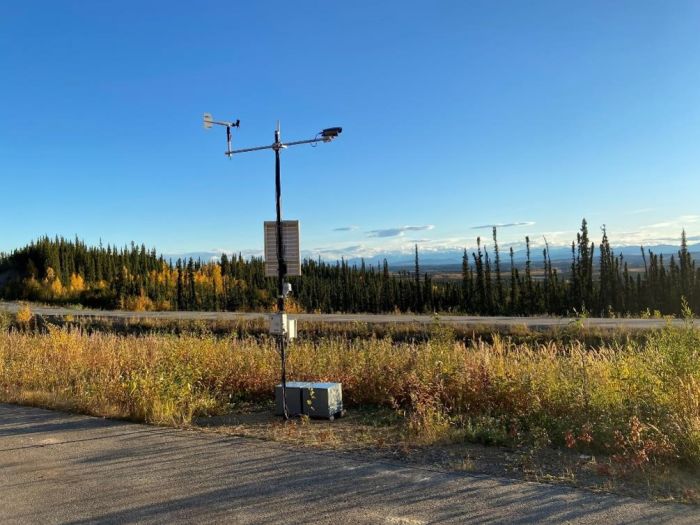


2019年、キャンベル・サイエンティフィックは、アラスカ州運輸公共施設局(ADOT&PF)と官民パートナーシッププロジェクトを開始し、スケーラブルな(ミニ)高速道路気象情報システム(RWIS)コンセプトを実証しました。このパートナーシップには、アラスカ大学バンクフェアス校 (UAF) の研究員がキャンベル サイエンティフィックのミニ RWIS ステーションのパフォーマンスを評価することが含まれていました。その目的は、ステーションのパフォーマンスと、アラスカRWISネットワークのギャップを考えるコスト効率の高いオプションとしてミニRWISステーションコンセプトを追加することの実現可能性について、ADOT&PFにフィードバックを提供することでした。
ADOT&PF は、アラスカのネットワーク高速道路に沿って約 70 の RWIS ステーションとカメラを管理しています。電力不足や携帯電話通信の不足により、現在の RWIS システム要件では機器やカメラを設置できない大きなギャップこれは保守作業の意思決定者にとっての課題であり、道路状況に関する一般への通知が制限されます。完全なRWISサイトを追加するにはコストがかかるだけでなく、安定した電源と機能する通信が必要ですが、現在は利用できません。Campbell Scientific は、ADOT&PF の設計およびエンジニアリング サービス (DES) と契約を結び、ADOT&PF が指定した 8 つのサイトで Campbell Scientific ミニ RWIS パイロット プロジェクトの設置、テスト、および全体的な有効性評価を実証しました。
この実証プロジェクトのために当初考え出された 8 台のミニ RWIS のうち、7 台は DOT 北部および南中部地域の検討された場所に通常に配置されました。雪崩リスクに関するデータ、予測、警告を提供する目的で設計されたアティガンパスのUAFプロジェクトに至りました。 このシステムは、複数のカメラ、吹雪センサー、ソーラーパネル/バッテリーシステム上のその他の大気センサーで構成されておりました。
アティガンパスのこのステーションは、ミニ RWIS コンセプトの一歩先を行くもので、アラスカ州に設置された最も北に位置する先進的な RWIS ステーションであり、気候条件が厳しい地域でデータを提供しています。そのため、ステーションの要件は、強風、華氏 -40度以下の気温、霧氷の可能性、2しばらくの間日光、携帯電話の接続性の欠如に耐えられるよう設定計りました。 控えめに言っても、この場所は機器の耐久性不足の課題がありました。
3年間のプロジェクト期間中、従来のRWISでは不要な情報が大幅に不足するアラスカ州で、ミニRWISのコンセプトが最大限応用可能であることが証明された。画像は、ADOT&PF の意思決定だけでなく、一般利用にも使用できます。Campbell Scientific のミニ RWIS ステーションから収集された大気データは正確で信頼性が高く、保守担当者のニーズに役立ちます。
RWIS の詳細については、道路気象情報システム (RWIS) の Web ページをご覧ください。
ケーススタディの概要
アプリケーション
ミニRWISステーションによるRWISネットワークの補完場所
アラスカの高速道路システム参加団体
アラスカ州運輸公共施設局 (ADOT&PF)計測項目
道路の気象状況、雪崩の危険性PDFで見る